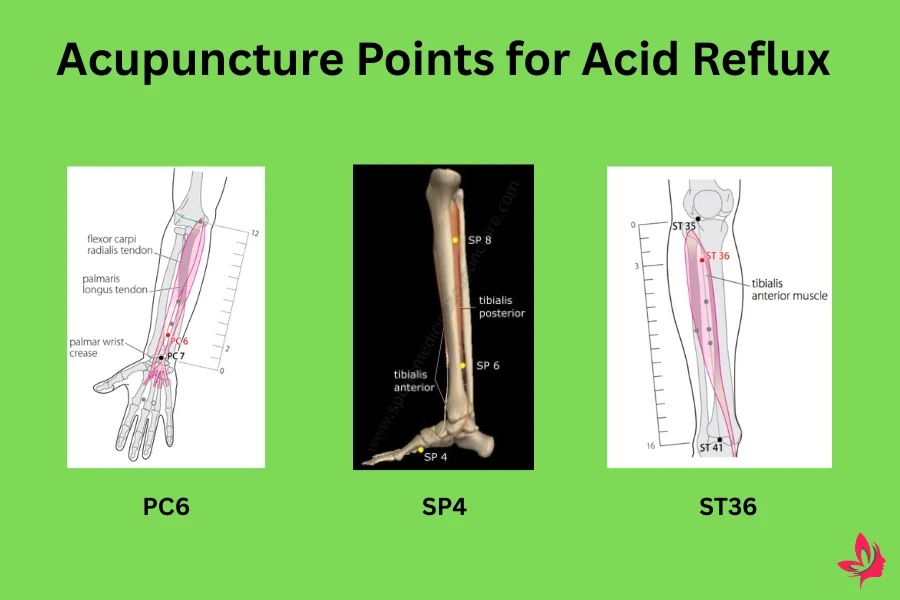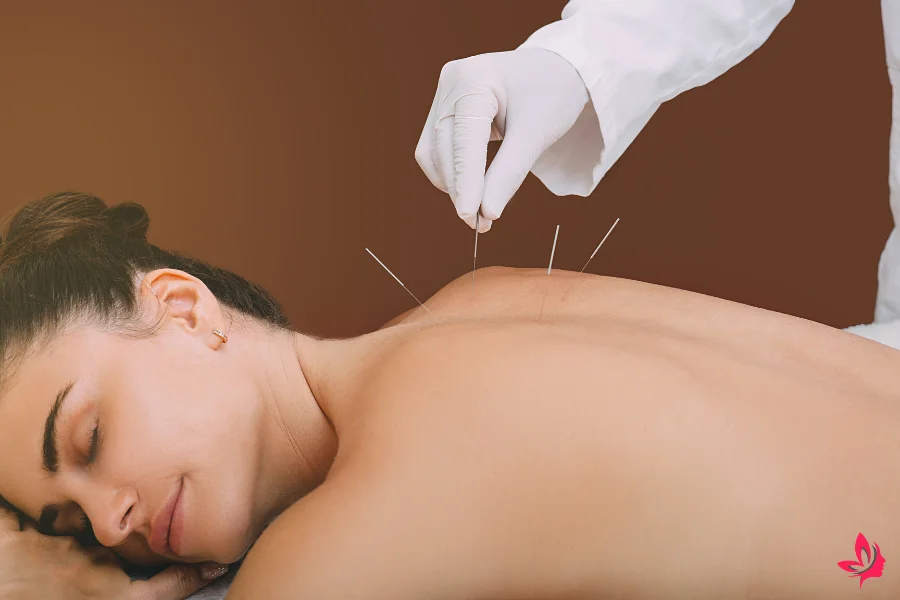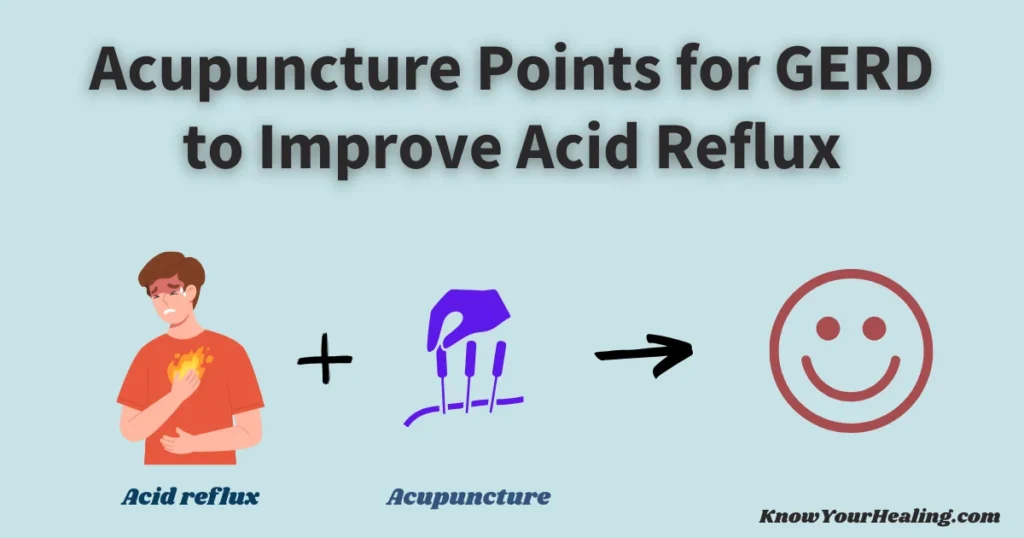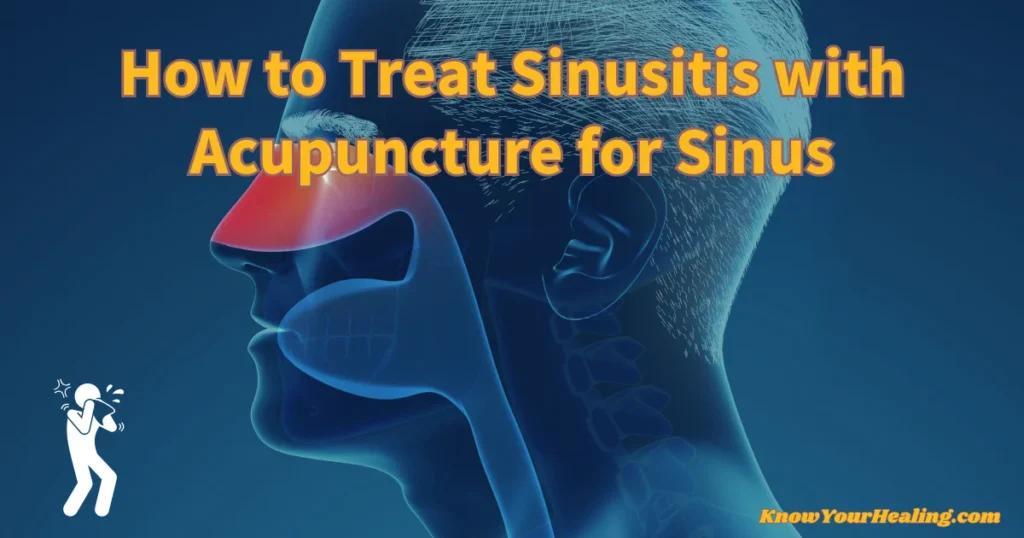Acupuncture points for GERD (Gastroesophageal reflux disease) can help people find relief from uncomfortable acid reflux symptoms.
Many struggle with heartburn, chest discomfort, and digestion problems, but there are safe methods that can support your health.
This article will guide readers through the most effective acupuncture points. It will also explain how they may improve daily comfort.
Specific acupuncture points like Pericardium 6 (PC6), Stomach 36 (ST36), and Ren 12 (CV12) help with acid reflux and other GERD symptoms. Practitioners use these points to balance the digestive system and ease discomfort.
You will also learn about the locations of these points and what to expect from an acupuncture treatment.
Learning more about acupuncture points for GERD and how they work can help manage acid reflux. This overview highlights key points as a helpful starting place for those interested in acupuncture for digestive health.
Understanding GERD and Its Symptoms

Acupuncture points for GERD target symptoms like acid regurgitation, burning pain, and digestive discomfort. The digestive system, especially the esophagus and stomach, plays a vital role in this chronic condition.
Common GERD Symptoms and Stomach Acid Imbalance
Symptoms of GERD come from stomach acid moving up into the esophagus. Heartburn is the most common sign and feels like a burning in the chest, usually after eating or when lying down.
Other symptoms include acid regurgitation, sore throat, and a bitter taste in the mouth. Some people may also feel stomach pain or have trouble swallowing.
Imbalance of stomach acid often results from diet, lifestyle choices, or medications. Chronic acid exposure can damage the lining of the esophagus and increase the risk of complications like Barrett’s esophagus.
Identifying symptoms early helps with choosing a suitable treatment plan, such as traditional Chinese medicine or lifestyle changes.
The Role of the Digestive System in Acid Reflux
The digestive tract includes organs like the esophagus, stomach, and intestines, which work together to move food and manage acids. GERD occurs when the lower esophageal sphincter (LES), a small muscle controlling the flow of stomach contents, becomes weak or relaxes at the wrong time.
This is called transient lower esophageal sphincter relaxations. Spicy and acidic foods, along with a poor diet, can make this problem worse.
In some patients, hiatal hernia or digestive disorders like irritable bowel syndrome may play a part. Acupuncture treatment uses specific points to support the flow of energy, or “stomach qi,” which may aid in digestion and symptom relief.
Chest Pain and Burning Sensation: Key Warning Signs
Chest pain and a burning sensation, sometimes felt in the upper chest or throat, are key warning signs of acid reflux. These symptoms can be mistaken for heart-related problems, but often result from acid moving from the stomach into the esophagus.
Symptoms may get worse with lying down, second-hand smoke, or emotional stress. Chronic heartburn can cause sleep problems and lower quality of life for adults with regular heartburn.
Acupressure points and gentle pressure on specific spots may offer a safe treatment option for managing discomfort, as explored in clinical practice.
How Acupuncture Points for GERD Work

Acupuncture points for GERD help regulate the digestive system by targeting specific areas that influence stomach acid production, esophageal motility, and symptoms such as chest pain or burning.
This approach offers a suitable treatment plan for those seeking gentle, drug-free relief from acid reflux symptoms.
Traditional Chinese Medicine Approach to GERD
Traditional Chinese medicine (TCM) views gastroesophageal reflux disease (GERD) as a problem of disrupted energy flow, particularly in the stomach and digestive tract.
Issues such as “stomach fire,” poor diet, or emotional stress can disturb stomach qi, leading to acid regurgitation and other symptoms.
TCM practitioners choose acupuncture points for GERD based on each person’s unique symptoms. They may combine therapy with herbal remedies and lifestyle changes, such as avoiding spicy foods and second-hand smoke.
Points like ST36 (Zusanli), PC6 (Neiguan), and ST36 (Leg Three Miles point) support digestive health and balance energy flow, reducing symptoms such as upper chest pain and sore throat.
Stimulation of Certain Acupuncture Points for Relief
Acupuncture treatment for GERD often targets points such as PC6 and ST36, located on the forearm and lower leg. These specific points have shown benefits in improving symptoms like acid reflux, chest pain, and a bitter taste in the mouth.
Stimulating specific acupuncture points works by modulating gut-brain communication and influencing the nervous system. Mild or electrical stimulation at these points can reduce transient lower esophageal sphincter relaxations, a leading cause of acid moving up the esophagus.
More on these points and clinical outcomes is available in scientific reviews.
Effectiveness of Acupuncture in Treating GERD Symptoms
Multiple studies and a systematic review report that acupuncture leads to significant changes in GERD symptoms compared to conventional treatment, such as proton pump inhibitors. Acupuncture can improve esophageal motility and reduce acid reflux symptoms.
Some research highlights a significant difference between acupuncture and sham stimulation. These findings suggest acupuncture is a safe treatment option with fewer side effects than drugs.
Key Acupuncture Points for GERD to Improve Acid Reflux

Acupuncture points for GERD can target chest pain, burning sensation, and acid regurgitation. Scientific studies show that stimulation of specific acupuncture points may offer effective treatment for symptoms of gastroesophageal reflux disease.
Specific Acupressure Points for Reducing Stomach Pain
Traditional Chinese Medicine uses specific acupuncture points to reduce stomach pain and soothe the digestive tract. Common points for GERD include ST36 (Zusanli), PC6 (Neiguan), and SP4 (Gongsun).
Research indicates these acupressure points may help manage stomach acid and improve digestive system health. ST36 is below the kneecap and helps boost stomach qi and relieve discomfort.
PC6, on the inner forearm, targets symptoms like nausea and heartburn. Stimulating SP4, near the inner arch of the foot, can help with abdominal pain and regurgitation of stomach contents.
These points are often chosen to address both mild and more serious gastric symptoms.
Gentle Pressure Techniques for the Digestive Tract
Gentle pressure to specific points is a safe and approachable way to support the digestive tract. Acupuncture works best when experienced practitioners apply mild stimulation using their thumbs or special tools.
This method avoids side effects common with proton pump inhibitors. Applying gentle pressure to PC6 and ST36 can support digestion and help reduce burning sensations in the upper chest.
This approach also helps adults who experience heartburn from acidic foods or a poor diet. Individuals interested in home care may practice gentle acupressure on these areas, but should consult an experienced practitioner for a treatment plan tailored to their GERD symptoms.
Managing Acid Regurgitation and Sore Throat Naturally
Frequent acid regurgitation and sore throat can make life uncomfortable for those with GERD. Research shows that stimulating points like PC6, SP4, and ST36 can reduce acid reflux symptoms by improving esophageal motility and lowering stomach acid exposure.
A systematic review found that acupuncture subjects experienced significant changes in symptom severity compared to the control group. Acupuncture may help manage persistent symptoms such as sore throat, burning pain, and even irritable bowel syndrome when included as part of lifestyle modification and standard treatments.
Some people use acupuncture as a complementary approach to conventional medicine and find relief without the side effects seen in drug therapy.
Comparing Acupuncture with Conventional GERD Treatments

Acupuncture has become important when looking at alternatives for treating symptoms of gastroesophageal reflux disease.
Treatments such as proton pump inhibitors and lifestyle changes remain common, but acupuncture offers a different approach for those seeking relief from stomach acid and burning sensations.
Proton Pump Inhibitors and Their Side Effects
Proton pump inhibitors (PPIs) are often the standard treatment for GERD symptoms in the United States. PPIs lower stomach acid and help with chest pain, acid regurgitation, and sore throat.
Some people experience side effects from PPIs, including stomach pain, diarrhea, headaches, and a higher risk of infections and vitamin deficiencies. Not all GERD patients respond well to PPIs and may need alternative treatments.
Systematic reviews show that for people who do not get relief from standard-dose PPIs, adding other therapies may be necessary.
Lifestyle Changes and Herbal Remedies for GERD
Lifestyle modification plays a key role in managing acid reflux symptoms. People are encouraged to avoid acidic foods, spicy foods, large meals, and second-hand smoke.
Other recommendations include better sleeping habits, weight control, and reducing emotional stress. Herbal remedies are also used in traditional Chinese medicine.
Herbs, when used under trained guidance, can help balance stomach qi and soothe the digestive tract. Acupuncture and herbal formulas together may provide lasting relief from digestive problems, according to a clinical trial.
Conventional Treatment vs. Acupuncture Group Results
Studies comparing acupuncture with conventional medicine show interesting results. In patients who did not respond well to conventional treatment, adding acupuncture worked better than doubling the dose of PPIs.
The acupuncture group reported more improvement in GERD symptoms, including chest discomfort and acid reflux. Stimulation of certain acupuncture points improves esophageal motility and helps regulate energy flow through key organ systems.
These changes can lead to short-term and possibly longer-term improvements for individuals with chronic GERD.
Tips for Safe and Effective Acupuncture Treatment

Acupuncture can help manage GERD symptoms like heartburn, acid regurgitation, and chest pain. Safe and effective results depend on professional guidance, healthy habits, and a thorough understanding of the research on acupuncture for digestive disorders.
Choosing Experienced Practitioners and Suitable Treatment Plans
Successful acupuncture for GERD relies on experienced practitioners who understand both traditional Chinese medicine and the digestive system. They select specific points near the stomach and esophagus to help balance stomach qi and reduce symptoms.
Patients should discuss their full medical history, including the use of proton pump inhibitors or conventional treatments, with the acupuncturist. A suitable treatment plan will consider other health factors such as a hiatal hernia or stomach ulcers.
Seek experts with credentials from national boards like the National Certification Commission for Acupuncture and Oriental Medicine (NCCAOM) in the United States.
Lifestyle Modification and Better Sleeping Habits
Alongside acupuncture, lifestyle changes are crucial for managing stomach acid and alleviating GERD symptoms. Avoiding spicy foods, acidic foods, smoking, and a poor diet can lessen burning sensations and stomach pain.
Gentle pressure or acupressure points may be used at home between sessions. Improving sleep by elevating the upper chest and head, eating smaller meals, and avoiding food before bed helps control acid reflux symptoms at night.
These habits support the effects of acupuncture and protect the digestive tract from regurgitation and further irritation.
Further Research and Systematic Review on Acupuncture for GERD
Modern science has begun to investigate the effectiveness of acupuncture in treating GERD. Studies show acupuncture may help symptoms by improving esophageal motility and reducing acid reflux, especially for those who do not respond well to standard treatment or have side effects from medication.
A systematic review highlights acupuncture as a safe treatment option with few side effects in most research subjects. Further studies are needed to compare acupuncture with sham stimulation and control groups to provide more precise answers about its long-term benefits.
Final Thoughts
Acupuncture points for GERD are gaining more attention as options to help manage acid reflux and related symptoms. Some people find that acupressure and acupuncture offer mild relief, particularly when applied to specific points, such as Pericardium-6 (P6) and Stomach-36 (ST36).
Researchers suggest that acupuncture can improve digestive function and may support other GERD treatments. Electroacupuncture is also being investigated for its potential to aid in gastrointestinal motility and alleviate acid reflux.
While some studies show promise, results can vary. Acupuncture and acupressure should not replace prescribed medical care.
Talking to a healthcare provider before starting these therapies is advised.
Key Takeaways:
- Acupuncture points for GERD include P6 and ST36.
- Research shows they may improve some digestive symptoms.
- Effects can be different for each person.
- These methods work best with medical advice and regular care.
Those interested in acupuncture for GERD may want to explore how it fits with other lifestyle changes and treatment options.
Frequently Asked Questions
Acupuncture for GERD targets certain spots on the body, such as points near the wrist and below the knee. These locations may help control symptoms like acid reflux and stomach discomfort.
Where is the acupuncture point for GERD?
One main acupuncture point for GERD is Pericardium 6 (P6), found about two thumb widths above the wrist crease on the underside of the arm, between two tendons. This point is often used for digestive problems, including acid reflux.
What is the best acupressure for acid reflux?
Pressing on Pericardium 6 is commonly used for acid reflux relief. Some practitioners also apply pressure to the Stomach 36 point, located below the knee.
Proper technique and positioning are essential for optimal results.
Can GERD be cured with acupuncture?
Acupuncture may help ease GERD symptoms and improve digestion, but it is not considered a cure. According to some research, acupuncture can be a safe option for managing symptoms, but it should not replace medical treatment.
What is the fastest relief for GERD?
For quick relief, people often use antacids or medications. Acupuncture or acupressure may offer temporary relief for some, particularly when used in conjunction with standard treatment.
The speed of relief can vary by person.
What is the finger point for acid reflux?
The most common finger-related point is Pericardium 6, which is pressed using the fingers rather than being located on the finger itself. This point is on the inner arm, a few centimeters above the wrist crease.
What is the best holistic treatment for GERD?
A holistic approach to GERD often combines acupuncture with lifestyle changes such as diet improvements, regular exercise, and stress management. Some may also use herbal remedies, but these should be discussed with a healthcare provider.
What is the best position to relieve GERD?
Sitting up straight or raising the head of the bed can help reduce acid reflux at night. Lying on the left side may also lower symptoms for some people.
What are the Counselling points for GERD?
Counselling may focus on healthy eating habits, avoiding late meals, managing stress, and understanding the proper use of medication. Patients are also advised to avoid triggers like fatty foods and caffeine.
Where is the site of pain with GERD?
GERD pain often starts in the middle of the chest, behind the breastbone. It can sometimes move up toward the throat.
Burning sensations are common.
Where is the stomach 36 acupuncture point?
Stomach 36, also known as Zusanli, is found about four finger widths below the kneecap, one finger width to the outside of the shinbone. This point is used to support digestive health and may help with acid reflux.




